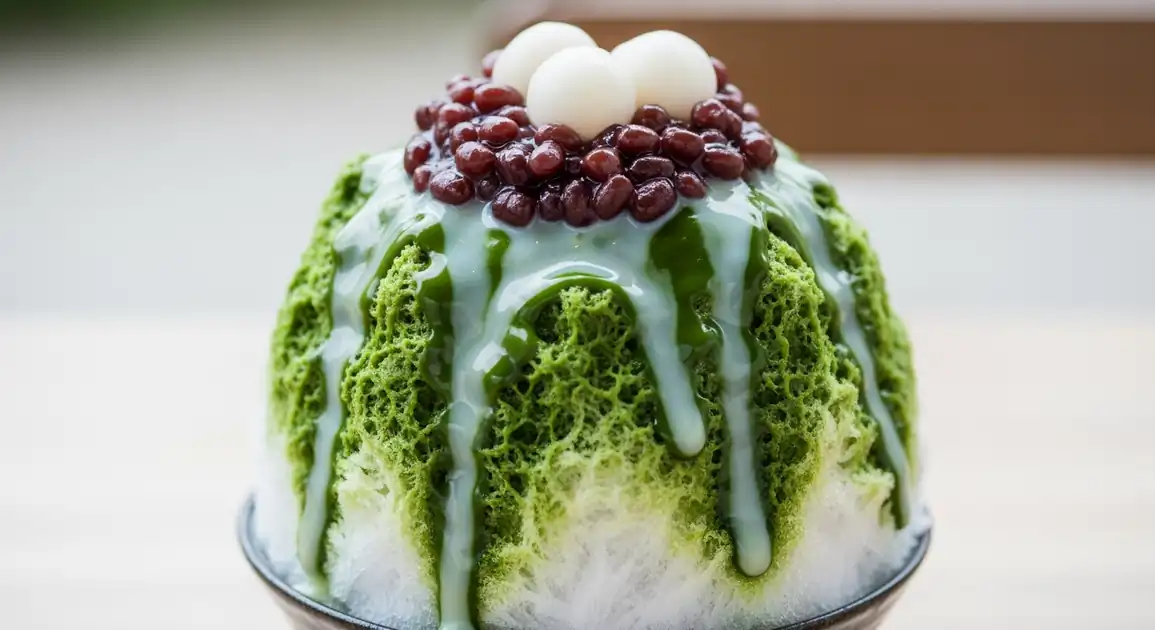Kakigori (Japanese Shaved Ice)
かき氷

Description
Tokyo offers an immense variety of Kakigori, from traditional neighborhood shops preserving classic flavors to cutting-edge cafes creating Instagram-worthy gourmet versions. Competition is fierce, leading to high quality and innovation, especially during summer.
Dietary Information
Serving information
Serving style
Ranges from simple paper cups at festivals to elaborate ceramic bowls or glassware in cafes. Always served with a spoon.
Quick facts
Specialty Shops: Often 11 AM - 6 PM or similar, but highly variable. Cafes: Follow cafe hours. Festival Stalls: Evenings (e.g., 5 PM - 9 PM).
Safety Tips
What to Look For
-
Extremely fine, fluffy ice texture
This indicates a quality shaving machine and proper technique, core to the Kakigori experience. Avoid coarse, chunky ice.
-
Cleanliness of the vendor/shop and machine
Japan generally has high hygiene standards, but always check that the machine, utensils, and serving area look clean.
-
Natural-looking syrups (especially in specialty shops)
While artificial syrups are common at festivals, specialty shops often use house-made or natural fruit syrups, indicating higher quality ingredients.
-
Use of clear, solid ice blocks
Good quality ice is the foundation. Some shops pride themselves on using specific types of pure or natural ice.
-
High turnover (especially at festivals)
Busy stalls mean the product is likely fresh and hasn't been sitting around, though Kakigori is always made to order.
What to avoid
-
Coarsely crushed or granular ice
This isn't true Kakigori texture and suggests a lower quality machine or different type of dessert.
-
Visibly dirty machine or serving area
Basic hygiene is essential, even for a simple dessert like shaved ice.
-
Syrups that look overly artificial or toppings that appear old
Opt for fresh-looking ingredients. While bright colors are common, excessively neon syrups might be lower quality.
-
Stagnant or dirty water visible near the preparation area
Clean water handling is important, although mains water in Japan is generally very safe.
Price information
Price range
Budget tips
- Explore older neighborhoods like Yanaka or Sugamo for traditional, less expensive options (around 500-800 JPY).
- Festival stalls (e.g., Asakusa Sanja Matsuri, Sumida River Fireworks) offer basic choices.
- Avoid peak times at famous shops to potentially skip cover charges or minimum orders sometimes found in cafes.
Value indicators
- Queue length often indicates popularity/quality.
- Unique, house-made syrups using seasonal ingredients.
- Mention of 'tennen-gōri' usually signifies premium quality.
- Artistic presentation in modern cafes.
- Fluffy texture maintained throughout.
Where to Find This Dish
Yanaka
Known for traditional atmosphere and shops like 'Himitsu-do' offering high-quality Kakigori, often with long queues.
Yanaka Ginza Shopping Street, Tennoji Temple
Daytime (check shop hours)
Asakusa
Mix of traditional tea houses and newer cafes serving Kakigori near Senso-ji Temple, busy during festivals.
Senso-ji Temple, Nakamise-dori
Daytime, Festival evenings
Sugamo
Known as 'Grandma's Harajuku', offers traditional sweets including classic Kakigori shops.
Jizo-dori Shopping Street, Koganji Temple
Daytime
Trendy Cafes (e.g., Shibuya, Shimo-kitazawa, Kichijoji)
Modern cafes often feature seasonal, highly photogenic gourmet Kakigori.
Various cafes, check guides/social media
Cafe hours, usually daytime/afternoon
Department Stores (e.g., Ginza, Shinjuku)
High-end depachika or restaurants within department stores often feature premium Kakigori.
Mitsukoshi, Isetan, Takashimaya
Store hours
Vendor Tips
- Check shop opening hours and days, especially for popular specialty places which may have irregular schedules or close when ice runs out.
- Be prepared to queue, sometimes for over an hour, at famous shops like Himitsu-do.
- Look for seasonal specials ('kisetsu gentei') featuring unique fruit or flavor combinations.
- Some popular shops may require reservations or have a ticketing system.
How to Order
Regional Variations
-
Gourmet Kakigori
(高級かき氷 / 進化系かき氷)
Tokyo excels in 'evolved' Kakigori with complex flavor layers, foams, premium fruit, sometimes alcohol-infused syrups, often at higher prices (1500-3000 JPY).
-
Savory Kakigori Elements
(食事系かき氷)
Some avant-garde places experiment with savory elements like tomato, corn, or cheese, pushing the boundaries of the dessert (rare).
-
Collaboration Kakigori
(コラボかき氷)
Limited-time Kakigori collaborations between famous chefs, brands, or characters are popular events in Tokyo.
Cultural context
History
The origins of Kakigori trace back to the Heian period (794-1185), where ice was shaved with a knife and served with sweet saps to the aristocracy. It became more accessible in the Meiji period (19th century) with the advent of ice machines. Today, Kakigori is a beloved summer staple enjoyed by everyone, evolving from simple festival fare to elaborate gourmet creations in specialty shops, symbolizing the refreshing relief from Japan's summer heat.
Local significance
In Tokyo, Kakigori ranges from nostalgic neighborhood treats to high-fashion desserts, reflecting the city's blend of tradition and trendsetting.
Eating customs
- Eating quickly remains key.
- Appreciating the presentation, especially in modern cafes.
- Often one order per person in sit-down establishments.